 On 20th April 1534, prominent citizens of London were required to swear the “Oath of the Act of Succession”. Chronicler and Windsor Herald Charles Wriothesley recorded:
On 20th April 1534, prominent citizens of London were required to swear the “Oath of the Act of Succession”. Chronicler and Windsor Herald Charles Wriothesley recorded:
“all the craftes in London were called to their halls, and there were sworne on a booke to be true to Queene Anne and to beleeve and take her for lawfull wife of the Kinge and rightfull Queene of Englande, and utterlie to thincke the Ladie Marie, daughter to the Kinge by Queene Katherin, but as a bastarde, and thus to doe without any scrupulositie of conscience; allso all the curates and priestes in London and thoroweout Englande were allso sworne before the Lord of Canterburie and other Bishopps; and allso all countries in Englande were sworne in lykewise, everie man in the shires and townes were they dwelled.”
On the very same day, Elizabeth Barton, known as “the Nun of Kent” or “the Holy Maid of Kent”, was hanged at Tyburn with others, including her spiritual adviser, Father Edward Bocking, Richard Risby, Warden of the Observant Friary at Canterbury, and Hugh Rich, Warden of the Observant Friary at Richmond. They had been found guilty of treason by a bill of attainder following Barton’s prophecies against the king’s annulment. Barton had prophesied that if the king went ahead with the annulment and his marriage to Anne Boleyn then he would lose his kingdom within a month and “should die a villain’s death”. Charles Wriothesley recorded their hangings:
“This yeare, the 20th day of Aprill, beinge Mundaye, 1534, the Holie Maide of Kent, beinge a nun of Canterburie, two munckes of Canterburie of Christes Churche, one of them called Doctor Bockinge, two gray freeres observantes, and a priest, were drawne from the Tower of London to Tiburn, and there hanged and after cutt downe and their heades smitten of, and two of their heades were sett on London Bridge, and the other fower at diverse gates of the cittie.”
Click here to read more about Elizabeth Barton.
Notes and Sources
- Wriothesley, Charles, A chronicle of England during the reigns of the Tudors, from A.D. 1485 to 1559 Volume 1, printed for the Camden Society, 1875, p.24.
Image: Engraving of Elizabeth Barton. It is thought to be by Thomas Holloway based on a painting by Henry Tresham, and comes from David Hume’s History of England (1793–1806).
Henry was acting a bit like a despot here, I wonder did they display Elizabeth Bartons head on London Bridge as iv never heard of that happening with a woman?.
Based on the description, looks like all 6 heads (including Elizabeth Barton’s) were put on gruesome display!
Yes, Wriothesley states that all six were put on display.
What I find amazing is how far the influence of Elizabeth Barton went, how many of the nobles and old families, including the Poles, one of the most powerful families in the realm, high churchmen like Bishop John Fisher, and even Sir Thomas More, had either bought into her ideas, listened to them or found sympathy with them. Sir Thomas More did not agree with her speakings, but he had found nothing treasonous or heretical in her prophecies or her declarations, or so he wrote when harrassed by Cromwell on the matter. Henry himself and his councillors had even spoken with her or had listened to her. She seemed to have widespread support, but her prophecies had become dangerous and as she decreed that Anne Boleyn and the King would die soon, she and her confessors were considered to fall foul of the treason laws. Henry was now in full flown Supreme Head mode, he would have no-body saw otherwise, thus the oath, but he would also have nobody preach or spread lies against the new order, his new wife and his new heir, which is the essence of Elizabeth Barton’s witness.
The representatives of the public clubs and guilds being called forward to take the oath and his councillors is an important step to establishing Henry’s new order and authority in the heart of court and city. His use of terror, probably pushed by Cromwell, to enforce his new order when he could not spread that message, underlines that change, that determination to make the message of his new headship stick is almost an act of religious observance and sacrifice to the image of the King. Henry also used image and plays for this message; but the use of terror was his most foreful and most dangerous weapon. The two happenings above are frighteningly linked.